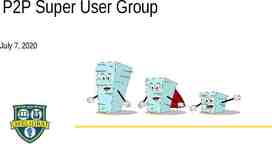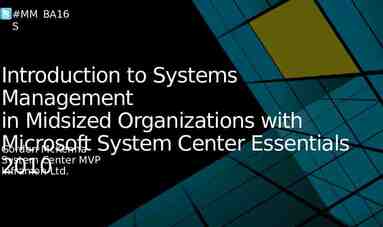The Evolution of Virtualization S o l u t i o n B r i e fi n g
27 Slides4.29 MB

The Evolution of Virtualization S o l u t i o n B r i e fi n g

The Evolution of Virtualization Traditional data center Virtualized data center Well-known, stable, and secure Utilization 15% Utilization increases to 50% Management costs decrease On-premises dynamic data center— private cloud Management costs decrease significantly IT as a Service Chargeback Off-premises dynamic data center—public cloud Capacity on demand Global reach S o l u t i o n B r i e fi n g

Microsoft’s Virtualization Strategy Microsoft integrated virtualization vision: Integrated architecture Common management system Comprehensive licensing Microsoft competitive feature set: Multi-vendor hypervisor management Guest monitoring Simplified, integrated management Extensive automation to further reduce costs of management Long-term commitment to virtualization and management: Windows Server 2008 R2 with Live Migration Windows Server 2008 R2 SP1 with Dynamic Memory System Center Virtual Machine Manager 2012 New versions of System Center family of products S o l u t i o n B r i e fi n g

How Is Virtualization Being Used? Implement Virtualization Use Virtualization Leverage Virtualization Server consolidation Rapid provisioning Dynamic data centers Energy and space High availability and desktops reduction Business continuity Accelerated Business value responsiveness “Why is virtualization such a big deal? A lot of people understand, and they think it's about saving money, it's about saving power, it's about green IT, it's about space, and that's certainly true. But in our perspective, it's much, much bigger than that, and people are just now beginning to understand that. We think that there's a major transformation taking place in IT. This major transformation that's been taking place for years is starting to accelerate, and we believe that virtualization is a major enabler and catalyst of that transition that's taking place.” - Tom Bittman, Gartner VP and Chief of Research of Infrastructure and Operations, at Microsoft’s Virtualization Launch S o l u t i o n B r i e fi n g Event

Versatile and reliable platform for all of your infrastructure and application requirements Hardware & Facilities Labor/Productivity Reduce hardware, Automate deployments facilities, power through Automate administration virtualization Remote management Reduce power Work remotely consumption Reduce network Solid Foundation for Enterprise bandwidth Security Data protection Network access Best practices analysis Software Broad capabilities, reduce suppliers Unlimited virtualization rights with data center edition Align return with Workloads investment Business Continuity & Compliance Performance, redundant systems, & sites Dynamic infrastructure Robust audit infrastructure S o l u t i o n B r i e fi n g

Hyper-V Server 2008 R2 SP1 Key features Live migration New processor support Improved performance Lower power costs Enhanced scalability Greater VM density Lower TCO Networking enhancements Improve performance 10 Gb/E ready Dynamic VM capabilities Enhancements to server core Ease management Lower TCO Dynamic Memory and Remote FX S o l u t i o n B r i e fi n g

Dynamic Memory Benefits More efficiently utilizes physical memory Enables accurate guest memory sizing Enables higher consolidation ratios A production feature Overview Memory is pooled and dynamically distributed across VMs Memory is dynamically allocated/removed based on workload—no service interruption Guest enlightened: guests and Microsoft Hyper-V work together 2 GB 1.5 GB 1 GB 512 MB Active Directory SharePoint Server Dynamics Server S o l u t i o n SCVMM B r i eServer fi n g

Rapid Provisioning—Business Agility Conventional Method Virtual Method Requestor submits purchase request Waits for purchase approval If approved: Server ordered IT needs to plan and allocate physical space and power Server arrives (Time? Days?) Physical installation OS loading, patching, and so on System ready Supply chain costs incurred Elapsed time? Weeks? Requestor submits online or email server request—or does it themselves via SelfService Portal IT locates a host with available CPU and memory Virtual machine template is chosen and loaded on the host Configuration is verified Guest becomes available No supply chain costs Elapsed time? Hours! S o l u t i o n B r i e fi n g

Hyper-V Licensing in the Data Center Licensed per server 1–4 processors 32 GB RAM 1 physical OS (POSE) 1 virtualized OS (VOSE) Workload: Physical servers and single-instance VM Licensed per server 1–8 processors 2 TB RAM 1 physical OS (POSE) 4 virtualized OS (VOSE) Workload: Lightly virtualized server Licensed per processor 2 processor socket minimum 1–64 processors 2 TB RAM 1 physical OS (POSE) UNLIMITED virtualized OS (VOSE) Workload: Highly virtualized Sserver o l u t i o n B r i e fi n g

Windows Server OS Comparison 9,000 Standard—1 VM 7,000 Enterprise—4 VMs 6,000 Datacenter—Unlimited VMs 5,000 8,000 4,000 3,000 2,000 1,000 0 Cost for a Dual Proc Server, no VMs 6 VMs Win Std Win Ent 12 VMs Win DC All costs represent 8/10 EZVL annual pricing EA Level A at 24 VMs S o l u t i o n B r i e fi n g

Hyper-V Server 2008 R2 SP1 Application Workload Performance Microsoft commission ESG Labs to test the performance and scalability of Hyper-V server virtualization technology Microsoft SharePoint 2010, Microsoft SQL Server 2008 R2 and Exchange 2010 workloads were tested with Windows 2008 R2 SP1 to confirm Hyper-V R2 SP1 can be used to virtualize tier-1 applications The successful outcome demonstrated a lower total lower cost of ownership, increased scalability, and maintained performance S o l u t i o n B r i e fi n g

SharePoint 2010 Application Workload Performance Summary of Results Adding web server VMs increased the number of 1% concurrent SharePoint users from 252,600 to 460,800. Average page response times improved as web servers were added. Average page response times were faster than the Microsoft-recommended guideline of 1–2 seconds. S o l u t i o n B r i e fi n g

SQL Server 2008 R2 Workload Performance Summary of Results Hyper-V R2 SP1 on a single physical server was used to deploy virtualized SQL Server 2008 R2 databases for 20,000 through 80,000 OLTP customers. Aggregate performance scaled up to 3,526 SQL Server batch requests per second during the four-VM test. Average transaction response times remained low (under 150 milliseconds) as VMs were added. S o l u t i o n B r i e fi n g

Exchange 2010 Workload Performance Summary of Results A single server virtualized with Hyper-V R2 SP1 scaled to meet the I/O)performance requirements of 20,000 Exchange 2010 mailboxes. Exchange database read response times remained well below Microsoft-recommended maximum of 20 milliseconds as VMs were added. Exchange 2010 Tested Solutions that were fully virtualized with Hyper-V R2 SP1 met the scalability and performance requirements of 9,000 through 32,000 highly available Exchange 2010 mailboxes. S o l u t i o n B r i e fi n g

Hyper-V Case Studies Available on Microsoft.com “ Hyper-V technology helps us run many virtual servers on a single cluster with performance nearly equal to a ‘native’ operating system. The result is a powerhouse of performance, manageability, and scalability. Dale Christian Chief Information Officer Avanade “ “ Hyper-V is an enabling technology that allows us to move toward a properly managed and standardized environment without increasing our costs. “ Marcel Berkhout Manager of Technical Services in the Americas Ingersoll Rand S o l u t i o n B r i e fi n g

Data Center Management Integrated, Comprehensive, Automated S o l u t i o n B r i e fi n g

Data Center Management Is An Expensive, Disconnected Set of Processes Dinner Now Tool 1 Tool 2 Monitoring Operator Application Configuratio n Order Tracker Web Order01 Tool 3 Tool 4 Storage Administrato r DN App. Dynamic Management Windows Server/ Virtualizatio n Administrato r Administrato r Tool 5 Network Administrato r S o l u t i o n B r i e fi n g

Power Rapid growth in management spending and virtual WW Spending on Servers, Power and Cooling, and machines Management/Administration 300 250 Physical Server Installed Base (Millions) Logical Server Installed Base (Millions) 80 Customer Spending ( B) 200 Managment Cost Server Spending 150 Millions Installed Servers Power and Cooling Expense 60 Virtualization Management Gap 100 40 20 50 0 0 '96 '97 '98 '99 '00 '01 '02 '03 '04 '05 '06 '07 '08 '09 '10 '11 '12 '13 Source: IDC Doc # DR2010 T2 MB S o l u t i o n B r i e fi n g

Drive IT Automation Across the Lifecycle to Deliver Quality IT Services Data Protection and Recovery IT Service Managemen t Monitor and Manage Service End-to-End Design, Configure, and Deploy Virtualize, Deploy, and Manage S o l u t i o n B r i e fi n g

System Center 2012 and Data Center Management Productive Infrastructure Predictable Applications Deliver flexible and costeffective infrastructure with what you already know and own Predictable application service levels delivered by leading monitoring experiences and deep application insight Heterogeneous support Process automation Self-service infrastructure Comprehensive application manageability Service-centric approach Deep application monitoring and diagnosis Your Cloud Private and public cloud computing on your terms managed with a common toolset Flexibility with delegation and control Common console across clouds Physical, virtual, and cloud management S o l u t i o n B r i e fi n g

Requirements, Challenges, and Opportunities for Data Center Management Deliver Reliable Services Operational Efficiency Improved Business Responsiveness IT service availability and performance-driving investments Virtualization still seen as key driver to reducing operational costs Cloud computing increasing expectations of IT in terms of agility and costs Application-focused virtualization/ management becoming increasingly important Need to efficiently manage virtualized environments Unpredictable business demand for data center services Compliance costs continue to rise with increased regulatory pressures Need for elastic and flexible IT capabilities to meet business demands Mixed environments add complexity Optimize service delivery Centralize management, invest in Enable cloud computing S o l u t i o n B r i e fi n g

Microsoft’s Key Messages Built-In Virtualization—Foundation for Cloud Virtualization built into the operating system with Windows Server 2008 R2 Hyper-V virtualization technology Virtualization in the management platform with the System Center suite of solutions Only solution with clear path for infrastructure and management into the cloud, with Windows Azure and System Center Unified, In-Guest Management Virtualized data centers and cloud infrastructures need comprehensive, physical, and virtual management Comprehensive automation to reduce cost and increase efficiency Only Microsoft System Center suite delivers: Unique heterogeneous management (Hyper-V, Linux, VMware) Host and unique in-guest management of applications and services Integrated physical and virtual OS management Single infrastructure, single license Coexistence with (no need to rip and replace) other hypervisors S o l u t i o n B r i e fi n g

Virtualization Summary Why enterprises are excited about Microsoft virtualization It’s the platform Data center to desktop you know Key feature of platform Tools you know Proven value Full range of products and solutions Large partner ecosystem Development to production End-to-end management with System Center Best total cost of ownership (TCO)/return on investment (ROI) Physical and virtual and crosshypervisor Interoperability Manage and secure all Windows Cost comparisons can be found at http://www.microsoft.com/virtualization/en/us /cost-compare-calculator.aspx and http://www.vmware.com/vmwarestore/ Fraction of the cost Significant savings Lower ongoing costs S o l u t i o n B r i e fi n g

Microsoft’s Approach Traditional data center Virtualized data center Well-known, stable, and secure Utilization 15% Utilization increases to 50% Management costs decrease On-premises dynamic data center— private cloud Management costs decrease significantly IT as a Service Chargeback Off-premises dynamic data center—public cloud Capacity on demand Global reach S o l u t i o n B r i e fi n g

System Center Cloud and Data Center Management Product/Capability Roadmap and Description S o l u t i o n B r i e fi n g

System Center Data Center and Cloud Management Components Virtual Machine Manager GA Q1 CY12 Provision flexible and cost effective IaaS Provision bare metal to fabric in a few clicks: pool and allocate data center resources (storage/network/compute cluster) Bare-metal server deployment Flexible delegation and role-based access control Service centric approach Service modeling templates Image-based management Server App-Virtualization (SAV) Multi-hypervisor support Unified management for Hyper-V, VMware vSphere 4.1, and Citrix XenServer virtualized environments Optimize service delivery Dynamic optimization based on workload demands Expanded Windows PowerShell support OVF support System Center Codename “Concero” Operations Manager Advisor GA Q1 CY12 GA Q1 CY12 RTW cadence, SA benefit Common application selfservice console across clouds Span multiple VMM servers Register and consume capacity from multiple Windows Azure subscriptions Enable multiple users authenticated using enterprise AD to access single Windows Azure subscription Deep application monitoring and diagnostics; “dev-ops” End-to-end transaction monitoring Monitor .NET apps (AVIcode) Monitor Java application servers Java applications management pack framework for third parties Application deployment and configuration Deploy and manage services and VMs on private clouds created with VMM 2012 and Windows Azure Copy service templates (and resources) from one VMM server to another Copy Windows Azure configuration, package files, and VHDs between Windows Azure subscriptions Network Monitoring Network topology discovery Network troubleshooting Easy to create, use, and share SLA dashboards and reports Full integration of AVIcode capabilities into Operations Manager (with System Center 2012, AVIcode will no longer exist standalone) Proactively avoid problems with server deployments through ongoing assessment and configuration alerting from a cloud service Resolve issues faster by providing support staff current and historical views into workload configurations Reduce downtime and improve performance of servers through proactive scanning for known configuration issues and best practices S o l u t i o n B r i e fi n g

System Center Data Center and Cloud Management Components Data Protection Manager Orchestrator Service Manager Configuration Manager GA Q1 CY12 GA Q1 CY12 GA Q1 CY12 GA Q1 CY12 Deeper integration and extensibility Integration pack refresh Additional data center workflows (richer integration with System Center components—such as for Service Manager Service Catalog) Support for ODATA web services standards Expanded PowerShell support Enhanced community support Enhanced user experience with Microsoft Silverlight console Service catalog Customizable request process Role-based access IT service management Release management Service request fulfillment Reporting and dashboards Centralized data warehouse Easy to use authoring Centralized management console Monitoring, troubleshooting, and remediation from single pane of glass Remotely manage DPM infrastructure Role-based access Extensibility and data deduplication Full application protection Restore as files Integration with key deduplication vendors Enhanced best-of-breed protection for Hyper-V, Exchange, SharePoint, and SQL Server Item-level recovery for Hyper-V and SharePoint Near continuous host-level Traditional/physical server provisioning Server and in-guest provisioning Desired Configuration Management (DCM) In-guest DCM Drive compliance by managing configuration drift Inventory Integrated management (enabled by CMDB) Orchestrator run book connector VMM service template connector S o l u t i o n B r i e fi n g






